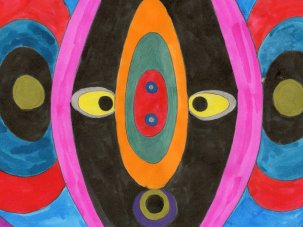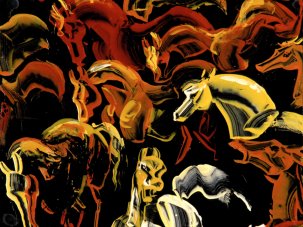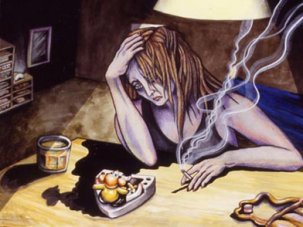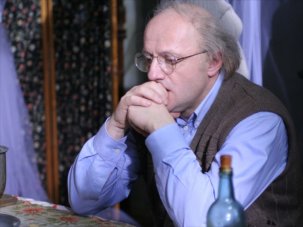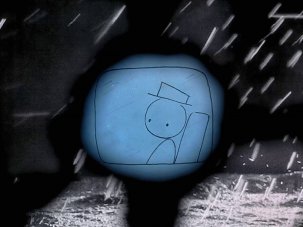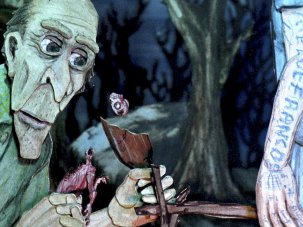There’s a whole realm of Japanese animation beyond the more visibly commercial face presented by anime. Outside the mainstream markets of cinema, TV and original video animation (OVA) studio productions lies a sizeable cottage industry comprised of independent craftsmen, illustrators and fine artists. These figures have explored alternative styles and techniques of animating their images, including cut-out, claymation, and stop-motion puppet animation, in an attempt to push the medium in new artistic directions.
The thriving tradition of independent animation, often referred to in Japan as ‘art animation’ (a term most of its practitioners reject), traces its roots back to prewar pioneers such as Masaoka Kenzô, Seo Mitsuyo and Ôfuji Noburô. The last of these worked on his decorative kiri-gami (‘cut-out’) techniques until 1956 and became one of the first Japanese animators to gain significant attention in the West, winning second prize for best short film at the 1953 Cannes Film Festival for his remake of his 1927 film Whale (Kujira) – realised through multicoloured collages of cellophane – and the Grand Prix at Venice for his final film The Phantom Ship (Yûreisen). Following his death in 1961 the Mainichi Shinbun newspaper established the Ôfuji Noburô award to recognise outstanding artistic achievements in short animation.
Subsequent pioneers have included Mochinaga Tadahito, Kuri Yôji, Kinoshita Renzô, Kawamoto Kihachirô, Okamoto Tadanari and Tezuka Osamu, the father of the manga comic book and creator of Astroboy (Tetsuwan Atomu), Japan’s first animated television series back in 1963. Tezuka also made a number of experimental works through his company Mushi Pro, and produced several more adult-themed feature animations in the early 1970s, reaching their zenith with the psychedelic, free-form expressionism of Tragedy of Belladonna (Kanashimi no Beradona, 1973), a study of witchcraft based on Jules Michelet’s 1862 La Sorcière.
Within animation circles such names are often mentioned in the same breath as such trailblazers as Russia’s Yuri Norstein, France’s Michel Ocelot and Britain’s Barry Purves. Still, Japan’s sheer wealth of animating talent only really became visible to the wider world when, alongside Miyazaki Hayao’s Oscar win for Spirited Away, Yamamura Kôji’s playfully surreal Mt. Head (Atama-yama, 2002) found itself nominated for Best Animated Short at the 2003 Academy Awards, paving the way for Katô Kunio’s The House of Small Cubes (Tsumiki no ie) to win in this category in 2009.
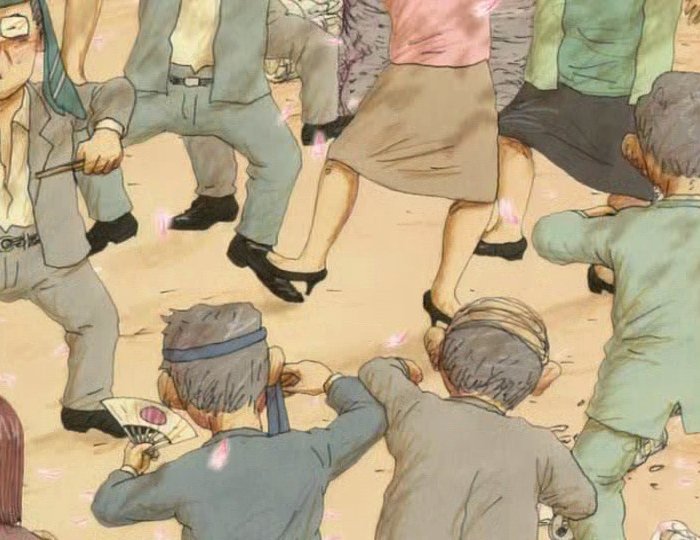
Mt. Head
The leading figure of his generation, Yamamura best represents the vitality, versatility and artistry of Japanese independent animation, and Mt. Head represents a pivotal point in an oeuvre that has drawn comparisons with influences as disparate as Paul Klee and Monty Python, while remaining true to its cultural roots. The tale of a stingy old man who plunges into madness after tearing out a cherry tree he discovers growing from his head from a pip he has swallowed, it provided the perfect taster to the director’s witty and often grotesque meditations on time, space and identity.
From his more experimental beginnings with the coarsely-textured, pellucid swirls of the underwater voyage Aquatic (Suisei, 1987) and the bilingual multi-media conundrums of Japanese-English Pictionary (Hyakka zukan, 1989), through the fearsome medieval grotesquery of Bavel’s Book (Bavel no hon, 1996) and onto the more abstract expressionistic pieces of recent years, Yamamura has risen to the forefront of Japan’s independent animation scene. His Franz Kafka’s A Country Doctor (Franz Kafuka Inaka Isha, 2007) won the Ôfuji Noburô Award, while 2011’s Muybridge’s Strings (Maiburijji no ito), his most recent work, was produced in conjunction with the legendary National Film Board of Canada.
I caught up with him at the London International Animation Festival in November, where he was both special guest and the focal point of a focus on the country’s new generation of independent animation artists. Much of that wave graduated from Tokyo Zokei University, where Yamamura himself studied and now teaches.

Yamamura Kôji
Jasper Sharp: What do you think of the term ‘art animation’, frequently used to refer to independent animation in Japan?
Yamamura Kôji: I don’t like it. It’s difficult to define what ‘art’ is. All films have some artistic aspects somewhere in them. I prefer the term ‘independent animation’.
Your company Yamamura Animation is essentially a one-man show.
It’s me and my wife Sanae. We met at university. She’s an artist who does a lot of abstract paintings. She’s not an animator or an illustrator but she can help with things like inking or colouring. In fact, she’s a far better artist than me. But I do all the artwork and directing for my films by myself and also come up with the original ideas, although we do discuss various ideas about the artwork together.
Your early animations use a variety of media, from hand-drawn to claymation, cut-out and even live-action footage. However, your work over the past decade is almost completely hand-drawn.
Generally, I see my work as belonging to three distinct phases, each fitting within a specific decade. For example, my films in the 1980s were very experimental in style as I attempted to find my voice. In the 1990s, I worked on more commercial projects, such as children’s animation that screened on television. And in the 2000s, from Mt. Head onwards, I’ve made films aimed at an adult festival audience.
My career really started in oil painting, which I studied at Tokyo Zokei University in the 1980s. When I was growing up I really wanted to be a manga artist, so I drew a lot of my own comic books as a teenager. Drawing feels very natural to me as I’ve been doing it for so long. It’s the easiest way of expressing myself.
You worked quite a lot using claymation too, for example in the three Karo & Piyobupt (Karo to Piyobuputo) short children’s films made for NHK [Japan’s state broadcaster] in 1993. Is this more suitable for a certain type of story or expression?
I think you get more of a sense of freedom and spontaneity with claymation. You can see how things are coming out as you are shooting and can respond accordingly. There are other pleasant unexpected outside elements that enter the work too, such as lighting and texture.

Aquatic (Suisei, 1987)
Tell me about your first film, Aquatic.
This was my university graduation project, shot on 16mm. It was made by drawing images using thin layers of clay on glass lit from beneath. The various areas of clay were dyed different colours, so the light shines through a bit like stained glass. This technique was also used in the final Karo & Piyobupt film, Imagination (Ame no hi).
The film was inspired by M.C. Escher’s print Three Worlds, which depicts a large pool in autumn in which you can see a large fish under the surface, leaves floating on top and the reflections of trees, although you can’t see the trees themselves. In my film, a man looks at his reflection in a pond, then throws an apple into the water, breaking its surface, before beginning to imagine how he looks from the perspective of the fish beneath.
I often play with the idea of reflections in my films – how we only know ourselves from our own subjective positions, even when we’re looking in a mirror. We never really get a sense of how we look or act from an outside perspective. We only exist in our own minds. You can see this in the opening scene of Mt. Head, when we look at the main character for quite some time before we realise he is actually looking at himself in the mirror.
My other major inspiration was the Indian animator Ishu Patel’s film Afterlife (1978), made for the National Film Board (NFB) of Canada. He was a jury member for the first Hiroshima International Animation Film Festival in 1985. After seeing his films I really wanted to make my own experimental and artistic animations like this.
What about other influences?
The Russian animator Yuri Norstein, the Estonian Priit Pärn. There are so many…
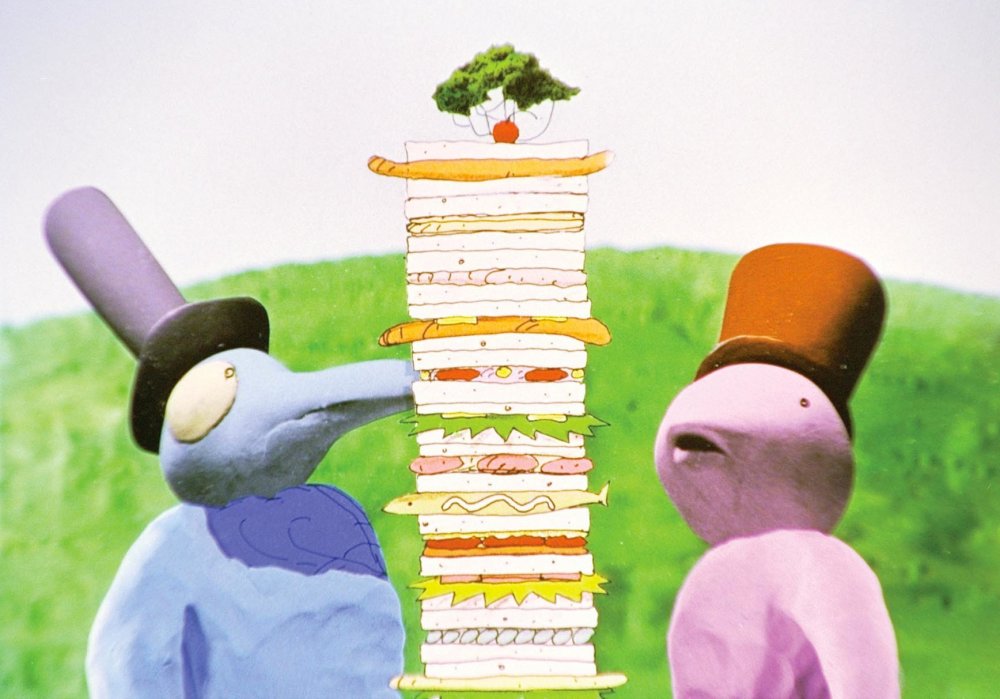
Karo & Piyobupt (Karo to Piyobuputo, 1993)
A lot of different influences came together in your second film, Japanese-English Pictionary (1989).
I was a member of an independent animation group at the time called Animation 80. It was rather like the CALF Collective featured in this year’s LIAF. Other members included Kurosaka Keita, whose film Midori-ko is also playing at LIAF, and the husband and wife team known as IKIF [Kifune Tokumitsu and Ishida Sonoko], who make very abstract animations – Kifune was also at Zokei with me, but a bit my senior. Generally, it was art students who were around university age, making independent films on 8mm or 16mm. We used to organise an annual screening of our work. It was like an independent movement, with lots of collaborative projects.
This led to the children’s animations for NHK?
Through these independent connections, I had a friend who worked a lot in claymation. We sometimes screened our work together in a small theatre. He introduced me to NHK, who were looking for claymation animators. I made the three short Karo & Piyobupt films and a longer title, Pacusi (Pakushi, 1995) for them. Then there were a few other films like Kipling Jr (Kippuringu Jr, 1995) and Kid’s Castle (Kidzu kyassuru, 1995) that weren’t for NHK. This last one was for the Kodomo no Shiro (Kids Castle) children’s charity.
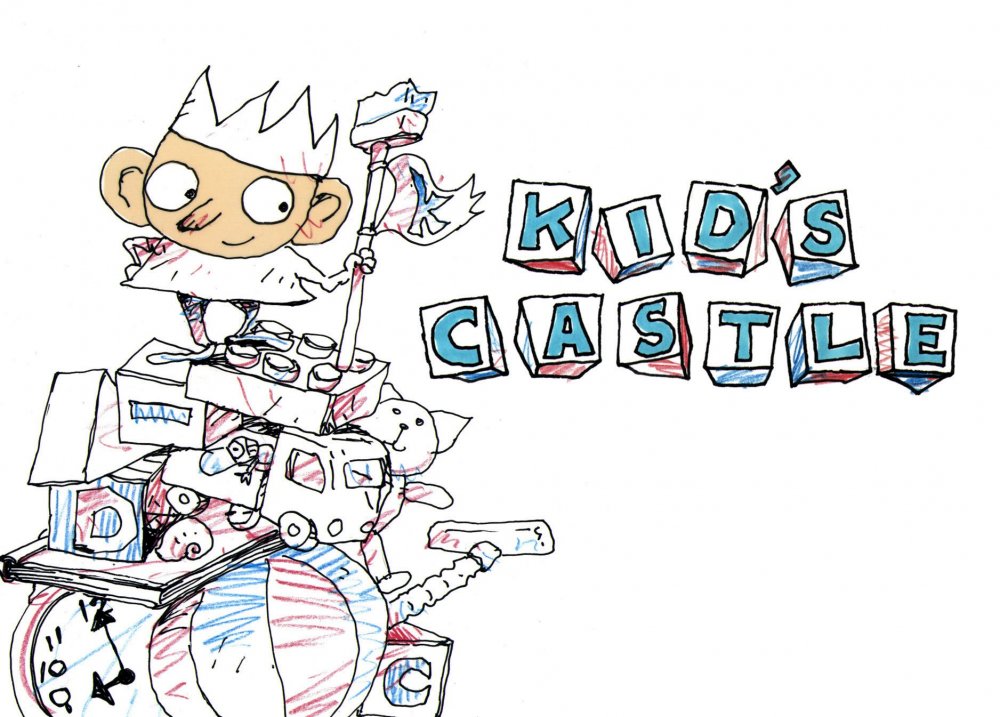
Kid’s Castle (Kidzu kyassuru, 1995)
Kid’s Castle is one of my favourites of your early films. It feels very fresh and spontaneous, using very simple line sketches.
It was the quickest I’ve ever made – it took just two weeks to complete a five-minute animation.
The Karo & Piyobupt films were also very quick – two and a half months for three four-minute films. That was all the time they gave me. It was very tough. I really felt at the time, “Agghhh… I can’t do this!” Nowadays I only work a normal eight-hour day, and make sure I get a proper night’s sleep.
It seems that your last film for NHK, Bavel’s Book, is something of a transitional work. While made for a younger audience, it anticipates the look of your films of the past ten years, particularly Mt. Head.
At that time I pitched a few ideas to NHK. I wanted to do a long series based on the Argentinian writer Jorge Luis Borges, who I’ve always really loved. I had this idea to do about 20 episodes, but there wasn’t the budget. But they had some money left over from another project so they allowed me to make this sort of demonstration version, although in the end I decided to make it for kids.
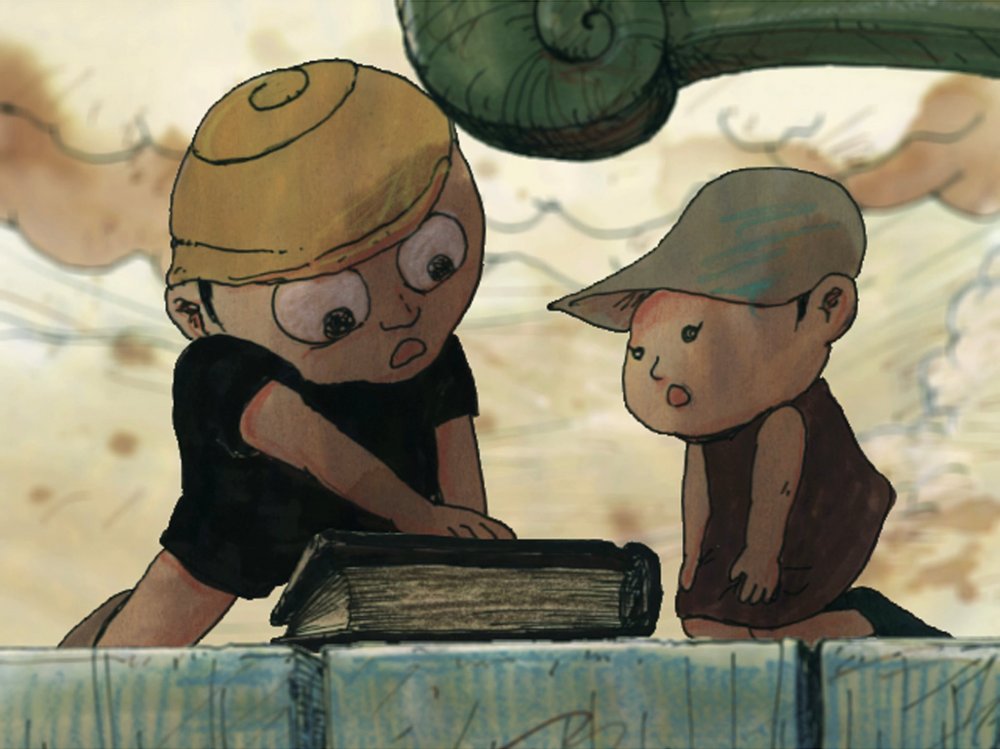
Bavel’s Book (Bavel no hon, 1996)
It was a long time between this and Mt. Head, which really put you in the public eye when you were nominated for an Oscar.
I spent six years preparing Mt. Head, but during this time I was supporting myself with a lot of commercial work, including illustrating children’s picture books.
From the very beginning with films like Aquatic, I always thought of myself making independent animations. I was just waiting for the opportunity. It wasn’t a great time for independent animation in Japan. A lot of people of my generation were quite successful commercially but couldn’t get the funding for their own projects.
How did this influence your working methods?
Mt. Head is based on an old story from a very traditional form of comic storytelling called rakugo, but I wanted to set it in contemporary Tokyo. One of the things I experimented with during this long gestation period was how to depict the city. I opted for a very simple, almost abstract style of drawing the skyscrapers and city background, but the characters and foreground objects are very detailed. For the character animation, I used two layers, one for colour and line and the other for the shading. It is the complete opposite of the style of most commercial animation, where the backgrounds are very detailed and the character designs much simpler.
Even though you avoid the anime aesthetic, you integrate very self-consciously Japanese elements within your work.
At the beginning, I never really wanted to include any specifically Japanese elements, because I’d started making animation through all these influences from Europe or Canada. But as I started travelling to foreign film festivals and seeing my work from outside, I realised that there were all these intrinsically Japanese elements within it, and after all, I am Japanese. And so from Mt. Head, I started to incorporate these more consciously.
At the time of Mt. Head’s Oscar nomination in 2003, I remember the Japanese media emphasising that everything was hand-drawn. This was a time when 3D CG was becoming more and more the norm in commercial animation. To what extent do computers feature in your work?
I’ve done all the compositing on a computer since Bavel’s Book in 1996, although I first used one for the production of Pacusi in 1994, after I bought an old Quadra Classic Mac. For Muybridge’s Strings I tried to go for a more simple look with fewer layers, so used the process more sparingly. The same with Old Crocodile (Toshi wo totta wani, 2005): I only really used it for overlaying the characters against the background.
Yes, Old Crocodile has a remarkably simple style in comparison.
I’d planned to make Muybridge’s Strings just after Mt. Head, but couldn’t find any funding on the Japanese side, so decided to do a slightly simpler project. Old Crocodile took around one year and two months, which has been my usual working period for each film.
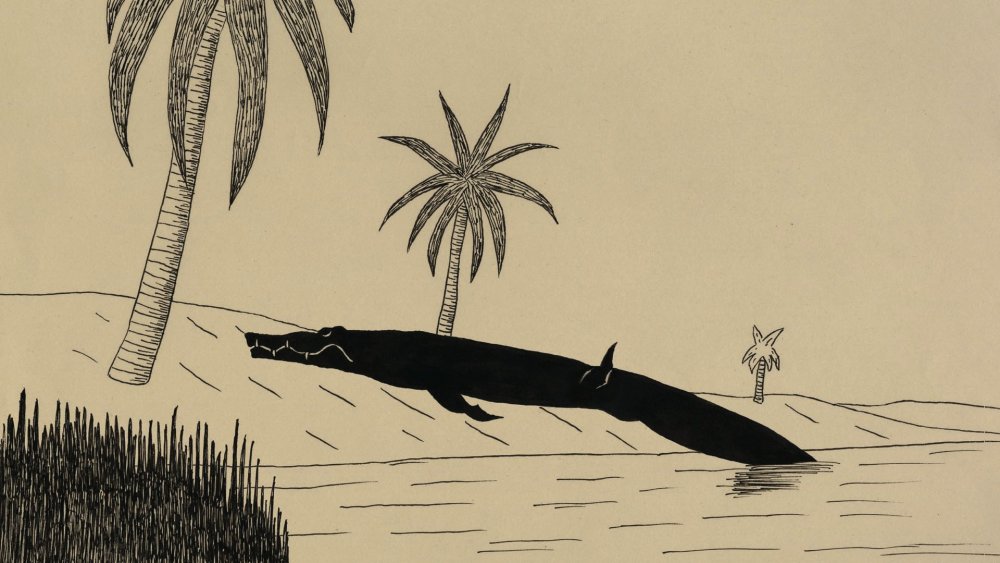
Old Crocodile (Toshi wo totta wani, 2005)
It’s based on Histoire du Vieux Crocodile by Leopold Chauveau, a children’s writer largely forgotten both in France and all around the world, who wrote a lot of stories about animals. For some reason, these are still published in Japanese, which is how I came across this story. When it first appeared in 1923, someone else did the illustrations but a few years later the second edition had illustrations by Chauveau himself.
I was very fond of these pictures, as well as the story itself, and used them as the basis for my character designs. It’s the only time I’ve made an animation using characters that weren’t my own. I had to fill in a lot of scenes that weren’t in the book, so I made 3D models of the main characters of the crocodile and the octopus to see what they looked liked from different angles.
What I found interesting about the character was that because of his age he commands quite a lot of respect, but actually everyone around him starts to hate him. The other thing was that neither he nor the octopus he meets can count, yet neither of them are intelligent enough to be aware of this. I started making this around the time America went to war in Iraq, and looking at the scary amount of authority the Bush administration had, this was something I wanted to try and get across in this story. I don’t think anyone noticed this aspect though. [Laughs.]
Franz Kafka’s A Country Doctor was your most ambitious piece.
I was commissioned to make this by the major film studio Shochiku. I had a really tight schedule. It’s 21 minutes long, but I still had the same period of time I usually take to make my films, 14-15 months. When the producer first approached me after Mt. Head, she had a number of different ideas. I wasn’t so keen on the others, but when they proposed Kafka, I immediately agreed, as he’s a writer I like a lot who has influenced a lot of art, films and animation.
I was drawn by the madness of the central character of the doctor and the fact that the narration is a first-person monologue, and rather than speaking the truth, this character tells lies and distorts reality. It isn’t obvious he’s lying when you read it, though if you look at the prose carefully, there are a number of things which seem strange, and this is something I felt I wanted to explore. I also had a very strong visual impression when I read it, which I thought could only be put across using animation. I use a lot of visual distortion to express the way the doctor’s thinking changes from moment to moment.
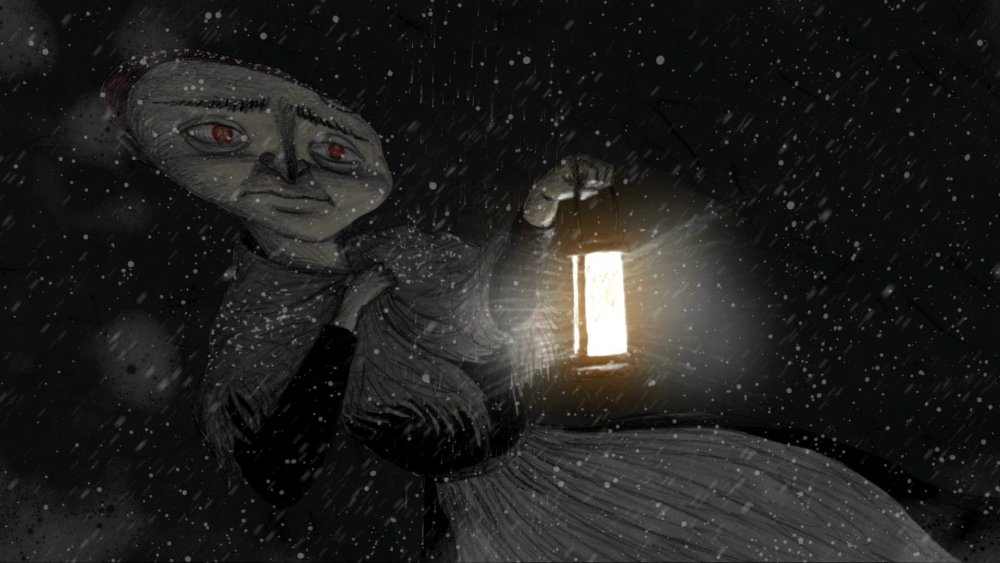
Franz Kafka’s A Country Doctor (Franz Kafuka Inaka Isha, 2007)
Kafka’s stories always have a sense of not being limited to one particular time or place, so I thought we could use a traditional Japanese art form to convey the story using the other different characters within it. I decided on kyogen, a traditional form of comic theatre that developed at the same time as noh. Both noh and kyogen have been practiced in exactly the same way for over 800 years, and they have a particular style of vocal delivery. In a kyogen performance you also have periphery characters who stand at the back of the stage wearing black, who sing and provide narration.
In Kafka’s story, the doctor’s monologue is split between the things he actually says to others, the things he says to himself and the things that probably only happen inside his head, and so from watching kyogen I had the idea of using different characters who are still the same doctor all saying different lines the come from this main character’s monologue.
The main vocal performance was provided by the kyogen actor Shigeyama Sensaku, who’s considered a living treasure in Japan. The other voices were performed by other members of the same Shigeyama house of kyogen actors. Kyogen traditions are usually maintained within family dynasties of performers and the Shigeyama family in Kyoto is one of the two most important in Japan.
What were you trying to convey with Muybridge’s Strings, your most recent work?
It was a collaborative work with the National Film Board of Canada. The NFB understand this kind of film but it is really difficult to get funding for non-commercial projects in Japan. We eventually got financing from NHK and Polygon Pictures, a computer graphics company who aren’t usually involved in this sort of animation, but the president of the company was personally very enthusiastic about it.
The film came from my own personal thoughts as I watched my children growing up – what had happened to the baby that was now my seven-year-old daughter, and where the past had gone. These were my thoughts as I started a series of sketches featuring animals in everyday situations. I came to think of these animals as representing a time that had passed.
Another idea I had in my head at the time was based on J.S. Bach’s ‘Crab Canon’, a short piece of music which is symmetrical, and sounds the same played forwards or backwards from its score. If you play this piece of music written hundreds of years ago now you can reproduce the past, while if you play it backwards from the end, you can bring this past back. So one initial idea was that while in real life you can’t go back in time, you can through this piece of music.
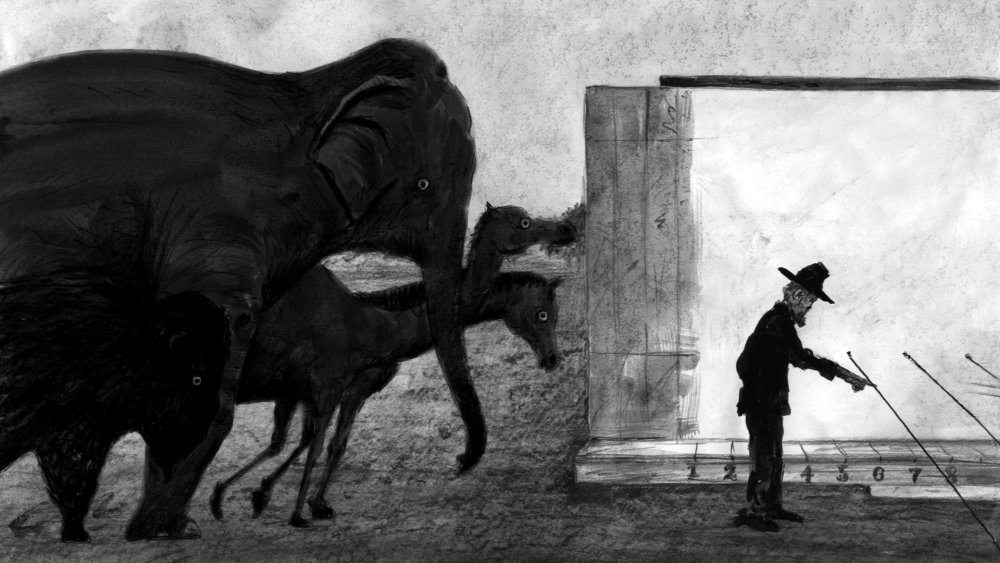
Muybridge’s Strings (Maiburijji no ito, 2011)
Initially I wanted to tell the story of a mother and daughter and the possibility of going back in time with this piece of music. Then I joined this to the idea in the title of Eadweard Muybridge, the photographer working in the UK and America at the end of the 19th century. I discovered what he had done was tie strings to 12 individual cameras, and it struck me how he’d used the strings to capture moments in time as they passed. So ‘strings’ became a key word in telling this story.
This is my third time in London now, but last time I visited the Muybridge museum in Kingston, where he was born. When I looked at his life I started to think of ways I could change the structure of the animation to contrast two different lives at two different times. The mother and daughter are connected and the daughter will become a mother, so it’s cyclical, like the ‘Crab Canon’, the same time repeated over and over again.
Muybridge, meanwhile, was a real person who was born and died on certain days, and led a linear life. He had a child, but it might actually have been fathered by another man, a friend of his wife. So Muybridge’s time really ended with his death. Moreover, he ended up shooting his wife’s lover, so he actually cut short another person’s time.
I found it ironic that in English, you use the same word ‘shoot’ to take a picture and to fire a gun, particularly in relationship to this man who has captured moment by moment the many fragments of time inhabited by other people and animals in photos, thereby continuing their existence in some form. Muybridge is very interesting as a person who symbolises the very beginning of film.
There was also a sense of greed or over-ambition in me to try and encapsulate the whole of time and space within the ten minutes of my short film. Seeing what Muybridge had done made me feel that we could fit eternity into ten minutes.
-
The Digital Edition and Archive quick link
Log in here to your digital edition and archive subscription, take a look at the packages on offer and buy a subscription.





